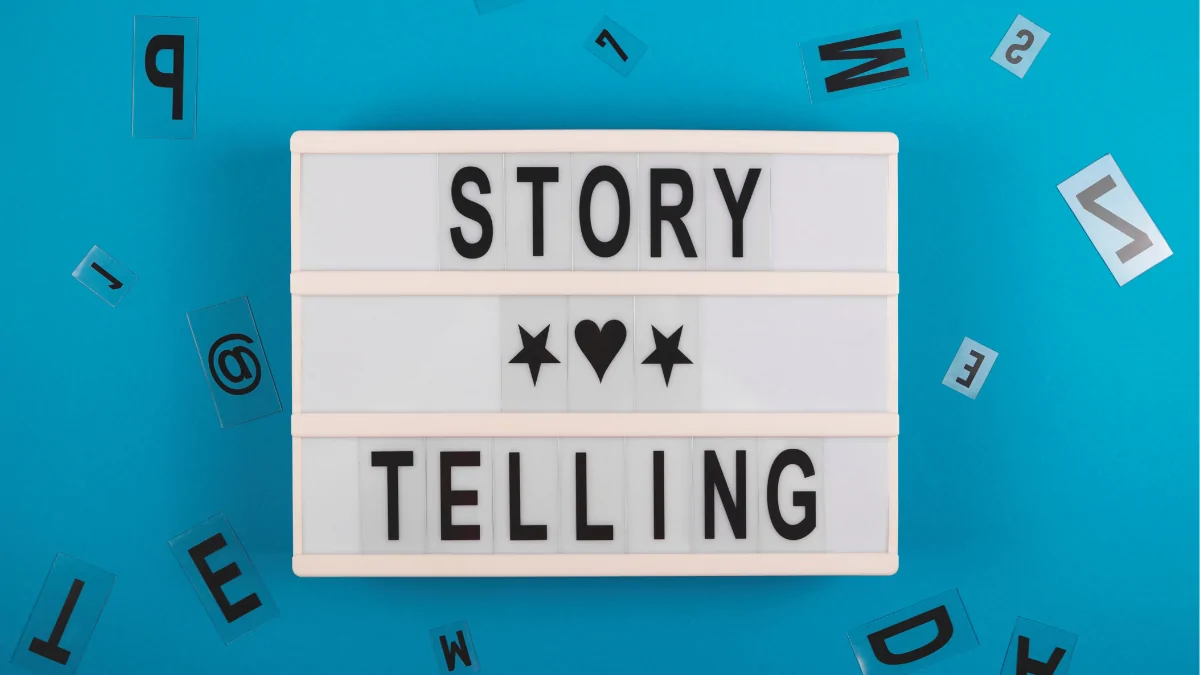Master the Art of Storytelling – Across All Major Social Media Platforms

Master the Art of Storytelling – Across All Major Social Media Platforms
Introduction:
Everyone loves a fantastic story! But not every story captures people’s attention while online. To get more from your followers than mindless scrolling or a double-tap, you need to connect with them in a way that matters. You may be giving a behind-the-scenes window into your life on Instagram, or you may be delivering a long-form story on YouTube. Regardless of how you’re sharing stories, the possibilities are countless.
Social media happens fast, but effective storytelling can still set you apart. And when your storytelling is done well, though the platform may change, people will keep coming back for more. This guide will show you how to develop stories that engage people, convert casual followers into fans, and set your brand apart on Instagram, TikTok, YouTube, X, and Facebook.
Why Storytelling Wins On Social Media
If you scroll through your social feeds, pay attention to what makes you stop. Is it a static image, that person doing the viral dance, or is it a story that resonates with you? When you stop to watch or click on something, it is because it was a story that you felt was real. Storytelling on social media is not an option; it’s the secret ingredient that separates the best creators, brands, and even your favorite meme pages from everybody else.
Stories Build Strong Connections
You’ll usually remember how a great story made you feel long after you’ve forgotten the details. Stories connect usernames to faces. They change plain old status updates into relatable moments we have shared together with our friends. When you tell something that touches your personal life to your followers, they don’t see you as just another account (that they are following). They see you as a real person. Think about relatable moments:
- The excitement of an unexpected visit from a friend
- That gut-punch moment you forget your keys
- The mini victory you have after your day has been tough
These are the little touches that make you human. If you share these, then your community feels like they know you.
Short Stories Grab Instant Attention
Social media has all kinds of distractions. In most cases, you only have a few seconds to hook someone. Short stories punch through the noise and stick. That immediate moment of emotion – the laugh, the surprise, or the intrigue, keeps your audience from scrolling past.
Use these quick hacks to get within seconds:
- Kick-off with a strong line or bold visual
- Be mindful and focus on one idea or moment
- Add some short reactions or real-time thoughts
You don’t need lengthy videos or threads. Very often, a single photo with a few words of agnostic honesty carries entirely more value than an elaborate production.
Content Sticks When It Feels Real
Real stories are often the easiest stories for people to remember. When you share real moments (the good, the bad, the ugly), your audience can see pieces of themselves. This is the way great content lasts after the scroll.
Here are some things that help stories last:
- Honest feelings, not just the highlights.
- Use plain language from the heart.
- Use detail: the burned toast, the walk in the rain, the dog’s goofy grin.
- If it feels genuine, it lasts.
Storytelling Sparks Trust
When you let people in, even just a little, you let in trust. Providing pieces of why things are important to you presents you as not having anything to hide. Your audience will start to root for you. They begin to comment, share, and even walk around all day telling their friends! Trust is built by:
- Sharing successes and failures.
- Responding in your real voice (skip the robot responses, please).
- Acknowledging others when you are telling a shared story.
- The more authentic you are, the more people want to engage with you.
Emotion Sells Your Message
Remember the last thing you saved or shared with a friend on social media? You probably had some kind of feeling when you engaged with the content. You may have felt something like joy, excitement, hope, or even sadness. That feeling is your competitive advantage. Stories create experiences and keep people moving.
Stories with emotion tend to generate:
- More comments (people relate and respond)
- More shares (followers want their friends to experience it as well)
- More engaged followers (they care, not just observe).
The next time you post, think about this: would this post make someone smile, laugh, or think for a second? If it does, you are close.
Key Ingredients For Social Media Stories That Stick
Good stories have a recipe, and if you know what to include, your updates will be more than a flash in the news feeds. They will be recognizable and memorable. When you think about each story, think about it as if you are sharing a quick story with a friend over coffee. You don’t need fancy language or pristine photos, but you want to create a real moment, relatable to them, share a simple message or lesson, and leave them with something to think about. Here are some insights in order to give your stories the details to make them stick, regardless of the platform.
Understand Your Audience
If you want your stories to land well, Each group on Instagram, TikTok, or YouTube has varied tastes and habits: some love the quick laugh, whereas others want behind-the-scenes tips or honest confessions.
Take these steps:
- Check your DMs and comments. Pay attention to which questions keep coming up.
- Review analytics. Note which posts had the most replies or most shares. This indicates what your people are responding to or connecting with;
- Ask directly. Using polls, questions (like IG stories), or going Facebook Live will help your followers tell you what they would like to see next.
- Take into consideration the platforms:
- On Instagram Stories, your audience prefers window-peek moments and life hacks.
- On TikTok, short-and-silly, or sharp and relatable, usually is a hit.
- On YouTube Shorts, curiosity and surprise are in the driver’s seat.
Now that you know your crowd, you can make content that fits their crowd. You will then mix it up by sharing about what they love and what is important to you. That’s when the content becomes sticky.
Keep It Real and Simple
Don’t get me wrong, high-quality videos, well-produced and edited, are fabulous, but realness wins every day in stories. Your audience can spot fake 1000 miles away. You will get remembered when you show up as yourself, talk in simple, true language, and share quick snippets of what your daily life experiences look like.
To keep it real:
- Use the way you speak when texting your best friend. Outline the fancier language and start using the way you talk every day.
- Use real images/photos or short videos. You may want to take a picture of your messy desk, the lunch you made, a silly pet moment- whatever fits your story.
Share wins and fails. Followers get that life is not perfect, so don’t try to be. Below are some strategies to develop your storytelling practice that are uncomplicated and authentic:
- If possible, keep your videos to about 30 seconds.
- Use “I” and “we” to make it more of a personal statement.
- Don’t overthink it—just say it how you would say it in person.
- When people see your human aspects, all their flaws, and a lot of quick laughs, they will remember you.
Visuals and Sound: Make Stories Pop
Stories happen quickly and fast, so you want to grab the viewers’ attention by using strong visuals, short clips, some sounds that accompany or match your video, and overall interesting clips that are less than 30 seconds. The reason is that you want to create short, clear visual clips no matter where you are sharing them. (Instagram Stories, TikTok, YouTube Shorts)
What to do to make visuals and sound work for you:
- Bright and clear images are eye-catching before someone reads anything.
- Short vertical video clips are the best way to fill up your limited 30-60 seconds.
- Short and simple edits (like text, stickers, or gifs) are beneficial when helping to make your messages.
- Captions are there for when people are watching it on mute.
Some platform-specific things:
- Instagram Stories: large caption fonts that are very readable, gifs of all different sizes. It is also fun to do mini-polls and sliders to encourage interaction.
- TikTok: lots of quick cuts, trends, and popular music to help your video pop. And don’t forget the captions—most people scroll TikTok in silence.
- YouTube Shorts: You need to hook the viewer immediately with bold visuals/sounds. Use background music, but make sure the music is lower so that viewers hear your words and not the music.
When you mix clear visuals and sounds with your messages, followers remember the message you are giving. This does not just look nice, but it helps your audience feel like they are experiencing that moment with you!
Storytelling Tips For Each Major Platform
Each social platform has its strengths, weaknesses, and advantages based on audience behaviors. If you want your stories to hit and make any sort of impact, you have to do more than copy, paste, and repost the same content everywhere. But if you have a structure and some intentional hacks, you’ll be able to tell stories that pop, no matter if you’re posting a video, swiping through photos, or sharing threads.
Instagram: Stories, Reels, and Carousels
When sharing short, snackable stories with mini-arcs, Stories and Reels are both excellent options. When posting a moment, do not just slap it on there as is; think of each frame like it is a small act in a comic strip. In Stories and Reels, here are the practices to follow to create a structure for your storytelling:
- Grab attention – Start with an awesome image, a weird moment, or a powerful statement.
- Create tension or suspense – Share a moment of tension or uncertainty about what will happen next with some foreshadowing (“Wait for it…” or “You will not believe…” will do this).
- Payoff – Show the result, punch line, or reveal.
Have a structured approach to carousels, too. Having pages that the audience can swipe through is like a mini-chapter book made for people scrolling. Chunk your story so each swipe is moving the story forward, but don’t let them lose sight of the goal. Here are considerations to maximize your carousel use:
- Start with a cover slide to show there is a story.
- Make each slide a scene (setup, build, reveal, and worth).
- Provide context with text captions or text overlays, but be brief.
- End with a call-to-action or key takeaway on the last slide.
Common mistake: Overloading carousels with text and randomness. Each swipe needs to be clear and then identifiable (easy to follow).
The Reels do best to tell a story and don’t just show a moment. The greater the resonance your Reel has with a viewer, the more likely to receive Reels likes from viewers who had a feeling, thought, or insight, even if it was just laughter or aspired to inspiration after they watched.
- Emotional flow creates engagement. Your Reel has a beginning/middle/end framework (even in 10 seconds), which keeps attention. And watch time counts, too.
- People like completeness. Reels that package a complete mini-story make people feel whole. This leads to a greater chance they will tap the like button.
- Consistency creates trust. Consistently producing story-based Reels leads to a better likelihood that viewers will engage with the account’s future posts. This consistent engagement is a way to receive new Reels likes over time.
In short, storytelling makes your Reels sticky, and sticky content gets shared, saved, and liked.
Carousels: Swipeable Stories That Stick
Carousels are like scrollable chapters. They are perfect for step-by-step, educational tips or mini guides. The point of carousels is to unpack one idea slide by slide, like the pacing in a story.
To build a narrative in carousels:
- Start with a promise. The first slide in the carousel should foreshadow what the viewer is gaining or learning.
- Focus each swipe on a singular theme. Treat each page as a scene: setup, details, insight, or more detail based on the theme.
- Be stingy with text. Too many details in one slide can destroy the flow. You are using punchy captions for the text.
- End with a purposeful end moment. Use an end frame with a CTA for the viewer to remember what the story is worth.
No matter if it is a 6-second TikTok, a 10-page carousel, or a 15-second Reel, storytelling is the glue that keeps the audience engaged through all the formats. When done well, it moves people from passive viewership to active fans, followers, or engagers.
TikTok: Fast, Fun, and Relatable
The attraction on TikTok comes down to how fast and with how much personality you can deliver the story. You only have one or two seconds to capture someone’s attention, so start with eye-catching visuals, fast movements, or a big reaction.
Here’s what you need to win at TikTok:
- Initial moments that surprise or seem out of the ordinary provide an opportunity for a pause in the scroll.
- Emulate trends if it is your voice. Put your spin so that you don’t fade into the background.
- Use hashtags that describe and highlight your moment, but have those hashtags fit naturally within the caption.
- Remixes of trending sounds, edits, or memes make these stories seem current and fresh.
It is ok to keep it light, direct, or completely relatable. Show the issue, show the solution, or maybe just yourself honestly reacting to a situation. Don’t overly explain. The audience wants to feel like they just stumbled on a little slice of your world.
Not getting caught in the trap of overloading a single story with every trend is a major pitfall in this space. When we lose the focal point of the story, we lose the audience.
YouTube Shorts: Quick Stories with Impact
Shorts are quick stories that are real, honest, and fast-moving. Shorts are home to where unfiltered stories can exist, but it is still important to let viewers leave with a clear answer to the story.
When recording your Shorts:
- Share a personal success, a personal failure, or a truly important lesson all in one go.
- Speak naturally; imagine you are talking to a friend about what just happened to you.
- Let your real self show.
- Start with the most interesting frame, not an introduction.
Have rawness, but be conscious of the journey. Even a messy behind-the-scenes story is still stronger with a conclusion – make sure you end with a statement or question. Don’t overdo it, but don’t go on and on. Just keep it real and keep it punchy.
X (Twitter): Threaded Stories and Updates
Threads allow you to tell a whole story one tweet at a time by breaking it down into quick, easy-to-read pieces.
To tell a story in threads:
- Start with a tweet to tease the main idea (or a strong opinion).
- Each tweet should push the story forward – think of them as mini-chapters.
- Use casual language and keep it lean on anything unnecessary.
- Spice the story up with some images or GIFs.
- End with something decided or a prompt.
The tone is important – stay conversational and direct. Write how you would talk if you were live-tweeting the event or moment. Quick, smart, and real is what works best.
Big pitfall: Don’t chew up space with too many tweets, or you lose readers. In general, a thread has to have a beltway to it and know when to end before someone’s attention goes away.
Facebook: Posts, Stories, and Groups
Facebook is the best platform because it provides you with many ways to tell stories through feed posts, group posts, and stories that appear at the top of your followers’ screens. Use these to maximum impact, not individually.
Here is how to combine formats:
Post photos with a caption that establishes the scene and either expands in the comments or a follow-up post. Bonus – you get to see more engagement in comments vs. a regular feed post.
- Stories are best when you mix them into momentary experiences — morning views, shoutouts, or reactions to events (especially if you know your audience skims their feed).
- In groups, use advanced and or checking-in posts (which have longer content) + photos to drive engagement.
- Use Facebook Stories for behind-the-scenes moments, polls, or shoutouts to community members (few rise to the occasion).
- Use short paragraphs and single thoughts per post to keep posts easy to read. Reply with human replies to drive discussion and conversations.
Big Pitfall: Don’t cut and paste all the content in the same manner everywhere. Construct every story for your format, audience, and purpose, and be deliberate. For example, if you are sharing a longer story in a group, require photographs and/or bold sections every so often to keep interest piqued.
Conclusion
You don’t have to be a professional storyteller to get people to care about what you are sharing. True stories, even if they are a little simple or rough around the edges, will be what’s remembered by followers. Every platform has its tricks, but none is more important than your authentic moments: share your true voice.
If you haven’t taken an opportunity to try these tips, jump in! It might feel weird at first, but the more you share, the more it will feel comfortable and natural. Over time, you are going to see real connections grow and your reach grow.
Thank you for reading. Now, go tell your story in real time where it matters. What you share could be the very thing someone needs to see today.
Author Bio :
Coraline Bennet is an SEO expert and a passionate content writer working at BuySocialfame.com. She has been working in digital marketing for two years and often contributes to reputable social media blogs.





